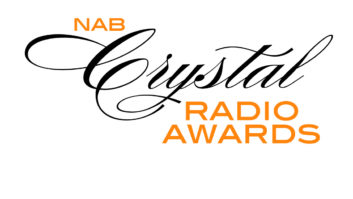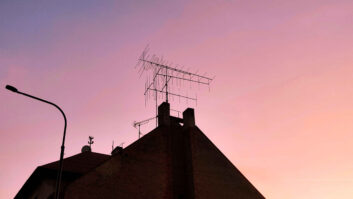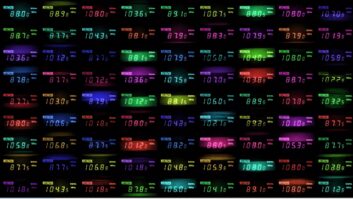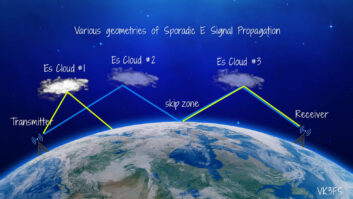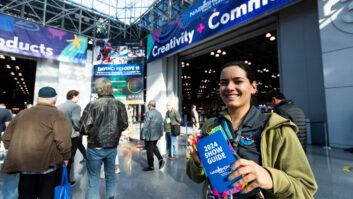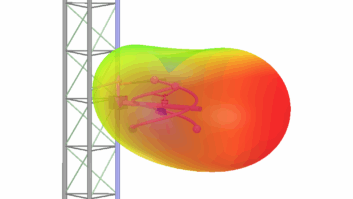The National Association of Broadcasters appreciates that the Federal Communications Commission wants to allow the use of computer modeling technology to verify performance of FM directional antennas. However, NAB recommends that the commission keep in place a number of “guardrails” in the rules.
Meanwhile, antenna manufacturer Electronics Research Inc. says it still has serious concerns about the proposal and worries about possible inaccuracies in computer modeling.
This article is a summary and update of our reporting on this issue to date.
FM radio is the only remaining broadcast service in the United States that requires physical measurements, thereby preventing manufacturers and broadcasters from relying on computer modeling to verify directional antenna problems.
Currently, applications proposing the use of directional FM antenna systems must include a tabulation of the antenna pattern through measurements performed on a test range of full scale or scaled model setup, commonly 4.1:1 or 4.5:1, according to the FCC.
The FCC adopted a Notice for Proposed Rulemaking in November based on a joint petition from antenna manufacturers Dielectric, Jampro Antennas, Radio Frequency Systems and Shively Labs and broadcaster Educational Media Foundation.
“We believe that giving license applicants the option of submitting computer models could provide meaningful relief to many FM broadcasters without jeopardizing technical standards or service to the public,” the commission wrote in its notice.
The proposal would relax the requirement for directional FM antennas operated by full-service and low-power FM stations in the United States. The FCC says there are about 900 directional FM stations licensed in the nation.
The most common reason to use a directional antenna by a commercial full-power FM is to allow it to “short-space” to another FM station while maintaining contour protection to that station.
The NAB in general supports the NPRM. It told the FCC that “computational simulation of FM directional antennas is already mature and produce computer modeling can produce comparable accuracy to physical measurements,” but still cautioned that “electronic modeling software is complex, can be subject to manipulation and limited by the accuracy and completeness of the input data.”
NAB continued: “Computer models can provide meaningful relief to FM broadcasters without substantially jeopardizing technical standards or service to the public. This approach should also lead to lower costs for antenna manufacturers and their broadcaster customers and allow for greater flexibility in transmitter site selection by FM broadcasters as tower space become increasingly precious.”
However, the association provided a list of requirements it would like to see maintained or newly, including a statement of the qualifications to the people responsible for the computer modeling and expansion of the rules to include specification of the mechanical and electrical properties of the antenna used in the model.
It also said the FCC should not require “in situ” measurements beyond ensuring the proper installation of the antenna and accept results from any appropriate electromagnetic modeling software. And because absolute accuracy is not achievable, the commission should not try to attain prediction accuracies that do not materially affect the interference environment.
In addition, it asks for limits of 15 dB max/min in the azimuth plane and of 2 dB/10-degree rate of change in the azimuth plane (see sidebar).
To demonstrate the accuracy of computational modeling, Dielectric, one of the original petitioners, submitted to the FCC a set of 53 comparisons of predicted directional antenna patterns derived from computational modeling overlaid with drone measurements of actual television antenna patterns. They were taken from its recent TV repack projects.
Shively Labs reiterated its support of the proposal and said the FCC should adopt a period of discovery and study to determine the best methods and most acceptable way forward while maintaining or improving the accuracy of directional antenna pattern studies.
ERI’s concerns
The majority of filed comments were supportive of the rule updates. But as we’ve reported, one antenna maker still had pause when considering the proposed changes.
Electronic Research Inc. said its experience has shown that computer models offer a good starting point. “Still, the final design of directional and nondirectional FM and television antennas should be completed and verified with measured azimuth patterns on either an antenna test range or in an anechoic chamber,” ERI wrote.
It told worries that the proposed changes would allow computer studies to confirm compliance with no verification that the performance of the computer simulation is accurate and correct.
In addition, the company notes that the FM broadcast band has a history of changes and additions to the types of services authorized, the power levels at which they have been allowed to operate, and the criteria used to site new facilities through modifications to the table of FM allotments.
“The result has been an ever-increasing number of authorized facilities and a continuing impairment of fringe coverage,” it said.
The ERI filing included details and testing to support its position that the changes would be detrimental to the public and the FM broadcast service, with its history of station growth and increasing congestion.
Comments from Hatfield & Dawson Consulting Engineers, which has extensive experience using electromagnetic modeling software, were supportive of the FCC proposal but asked for clarification of several sections of the NPRM.
“The text of the Notice of Proposed Rulemaking provides a clear description of the method of determining antenna pattern information by use of a test range or of an anechoic chamber,” it wrote.
“Some confusion may, however, result from the lack of a careful distinction between such test range or anechoic chamber measurements and measurements made in the far-field from operating antennas. This confusion may arise from the comparisons in the NPRM with the field measurement versus moment method procedure for proof of performance of AM directional antennas.”
The FCC in 2008 approved the use of the “method of moments” computer modeling technique to allow AM stations to conduct proofs of performance of directional AM antenna patterns without the use of actual field strength measurements.
Broadcast engineers familiar with computer modeling say the MoM approach has provided considerable savings in time and money for antenna manufacturers and AM broadcasters.
You can view filed comments about this issue here — just type “21-422” in the “Specify Proceeding” field.
Guardrail detail
NAB says errors associated with computational modeling are likely to increase with the depth of nulls in an antenna pattern.

“Most commonly, the purpose of employing a directional antenna by a commercial full-power FM station is to allow that station to short-space to another FM station, while maintaining contour protection to that station. The commission’s short-spacing rules provide a lower limit on the distance to which a station may locate with respect to other stations,” according to its filing.
NAB believes that the present 15 dB maximum-to-minimum ratio is adequate to allow for alternative transmitter sites within the spacing limits while minimizing the risk of interference.
The association also asks the FCC for a limit of 2 dB/10-degree rate of change in the azimuth plane.
“The pattern comparisons in the record demonstrate that the rate of change of the antenna pattern is critically dependent upon the accuracy of the data used in the model. Small errors in the physical dimensions used in the model can translate into larger errors in predicted antenna gain in a particular direction.
“Therefore, NAB recommends retaining the existing limitation that directional antennas that propose a radiation pattern in the azimuth plane which varies more than 2 decibels per 10 degrees of azimuth will not be accepted or authorized. This requirement helps ensure that modeled patterns will be realized in practice.”
Randy J. Stine has spent the past 40 years working in audio production and broadcast radio news. He joined Radio World in 1997 and covers new technology and regulatory issues. He has a B.A. in journalism from Michigan State University.

